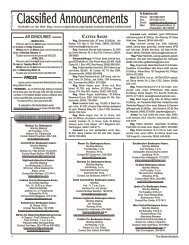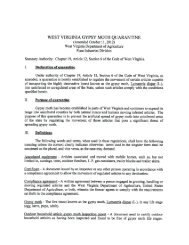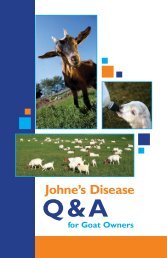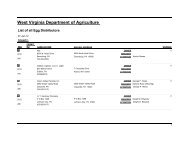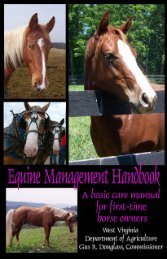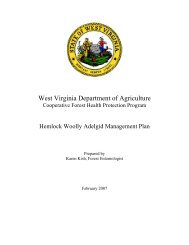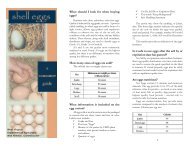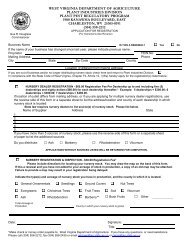Growing Grapes in WV - West Virginia Department of Agriculture
Growing Grapes in WV - West Virginia Department of Agriculture
Growing Grapes in WV - West Virginia Department of Agriculture
You also want an ePaper? Increase the reach of your titles
YUMPU automatically turns print PDFs into web optimized ePapers that Google loves.
1. The fruit is borne onshoots produced from oneyear-oldwood. One-year-oldwood is brown, reddish-brown,or gray, depend<strong>in</strong>g on thevariety, and the bark is tightand not peel<strong>in</strong>g. The amount<strong>of</strong> wood older than one yearshould be kept to a m<strong>in</strong>imum t<strong>of</strong>orm the framework for hold<strong>in</strong>gthe fruit<strong>in</strong>g wood.2. Severe prun<strong>in</strong>g results<strong>in</strong> an excess <strong>of</strong> wood and littlefruit, although both berries andclusters will be large. Lightprun<strong>in</strong>g results <strong>in</strong> the production<strong>of</strong> little wood and a largenumber <strong>of</strong> small clusters <strong>of</strong>small fruit. A balance betweenwood and fruit production isdesired to give a good crop<strong>of</strong> large clustered fruit andenough wood for good canesthe follow<strong>in</strong>g season. The number<strong>of</strong> buds to leave is cultivardependent. For most cultivars30 buds should be left for thefirst pound <strong>of</strong> one-year-oldwood prun<strong>in</strong>gs removed and10 buds left for every pound <strong>of</strong>prun<strong>in</strong>gs after that. If you remove3 pounds <strong>of</strong> one-year-oldwood, then there should be 50buds left on the v<strong>in</strong>e. These 50buds may be ten 5-bud spursor five 10-bud canes depend<strong>in</strong>gon your tra<strong>in</strong><strong>in</strong>g system.This allows a balance that willvary with the vigor <strong>of</strong> the plant.To do this, most <strong>of</strong> the woodis removed, leav<strong>in</strong>g more thanyou th<strong>in</strong>k should be left. Afterweigh<strong>in</strong>g what has been taken-12-<strong>of</strong>f, the buds rema<strong>in</strong><strong>in</strong>g canbe counted and more woodpruned <strong>of</strong>f to adjust the number<strong>of</strong> buds rema<strong>in</strong><strong>in</strong>g to fit the balancedprun<strong>in</strong>g equation.3. The best canes to keepfor fruit<strong>in</strong>g are those <strong>of</strong> mediumsize (about the size <strong>of</strong> a pencil)with plump buds. Canes with adiameter <strong>of</strong> one-fourth to onethird<strong>in</strong>ch and an <strong>in</strong>ternodallength <strong>of</strong> five to eight <strong>in</strong>ches(<strong>in</strong>ternode lengths are shorteron v<strong>in</strong>ifera and French hybridcultivars)-both measured betweenthe fifth and sixth nodesfrom the base - are consideredideal.4. The most productivebuds on the canes are cultivardependent, but generally thethird to n<strong>in</strong>th buds will produceshoots with the most flowers.5. The bear<strong>in</strong>g wood shouldbe close to the ma<strong>in</strong> trunk.This saves space and limits theuptake <strong>of</strong> plant food by unfruitfulwood. Choose wood andrenewal spurs (canes prunedto 2-3 buds to provide canesfor fruit<strong>in</strong>g the next year) closeto the permanent tra<strong>in</strong><strong>in</strong>g structure.Permanent structures<strong>in</strong>clude the ma<strong>in</strong> trunk andbranches (short arms or longcordons) that the fruit<strong>in</strong>g woodorig<strong>in</strong>ates from.Flower-ClusterTh<strong>in</strong>n<strong>in</strong>gFlower-cluster th<strong>in</strong>n<strong>in</strong>g is theremoval by hand <strong>of</strong> some <strong>of</strong> theflower clusters on each shoot to



